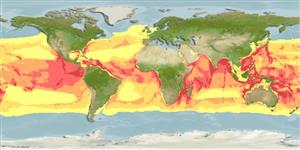Common names from other countries
Environment: milieu / climate zone / depth range / distribution range
Ecología
Pelágico; oceanodromo (Ref. 75906); rango de profundidad 0 - 4330 m (Ref. 116169). Tropical; 90°N - 90°S, 180°W - 180°E
Atlantic Ocean and Indo-Pacific: Stenella longirostris longirostris: Around oceanic islands in the tropical Atlantic, Indian, Western and Central Pacific east to about 145°W. Tropical, subtropical.
Length at first maturity / Tamaño / Peso / Age
Maturity: Lm 164.1, range 152 - 182 cm Max length : 240 cm TL macho / no sexado; (Ref. 1394); 200 cm TL (female); peso máximo publicado: 77.0 kg (Ref. 1394)
Spinner dolphins have various forms depending on their geographical locations. Commonly, these are small and slender animals that have a relatively long slender beak. It has a tripartite coloration which consists of a dark grey dorsal cape, lighter grey lateral field and a white or very light ventral field. A dark band runs from the eye to the flipper, bordered above by a thin line. It has a clearly discernible contrast of cape with the lateral field and a smooth curve on the ventral margin of cape over the eye. The ventral white field extends dorsal variably nearly to level of eye; margin speckled; genital and axillary areas confluent. It also has a high to medium contrast between flipper band and gular region wherein variable spots are visible. Its flippers are dark or speckled. In adult males the dorsal fin is falcate to triangular and has a small to medium protuberant ventral keel.
Dolphins are directly caught for use as shark-bait in Sta. Ana and Aparri, Philippines (Ref. 77119). Reside in coastal waters (Ref. 97368). May seek shelter in shallow sandy bottoms to protect themselves from predators (Ref. 80498). Observed year-round during daytime in sheltered bays or within lagoons. Forming schools ranging in size from 15 to 30 individuals to as large as 100 to 140 individuals (Ref. 97372). Feeds predominantly at night on deeper, offshore waters (Ref. 122680) and rest during much of the day (Ref. 1394); on small (5 to 10 cm long) fishes, shrimps, and squid in deep offshore waters from the mesopelagic boundary. Follows the diel horizontal migration as well as the vertical migrations of its prey (Refs. 97368).
Life cycle and mating behavior
Madurez | Reproducción | Puesta | Huevos | Fecundidad | Larva
Sexual maturity attained between 4 to 7 years (females, 165-170 cm) and 7 to 10 years (males, 160-180 cm). Promiscuous, with observable courtship display. Gestation period averages 10 months, produces only one calf. Born at 3-year intervals, calves are nursed for at least a year and weaned between 1 to 3 years (Ref. 80521).
Tan, J.M.L. 1995. (Ref. 936)
IUCN Red List Status (Ref. 130435)
CITES status (Ref. 108899)
Human uses
Pesquerías: comercial
FAO - pesquerías: landings, species profile | FishSource | Sea Around Us
Herramientas
Fuentes de Internet
Estimates based on models
Preferred temperature
(Ref.
115969): 2.6 - 14.4, mean 4.8 (based on 3285 cells).
Resiliencia
Alto, población duplicada en un tiempo mínimo inferior a 15 meses (K=0.41-0.54; tm=5).
Vulnerability
High to very high vulnerability (75 of 100).
Price category
Unknown.
